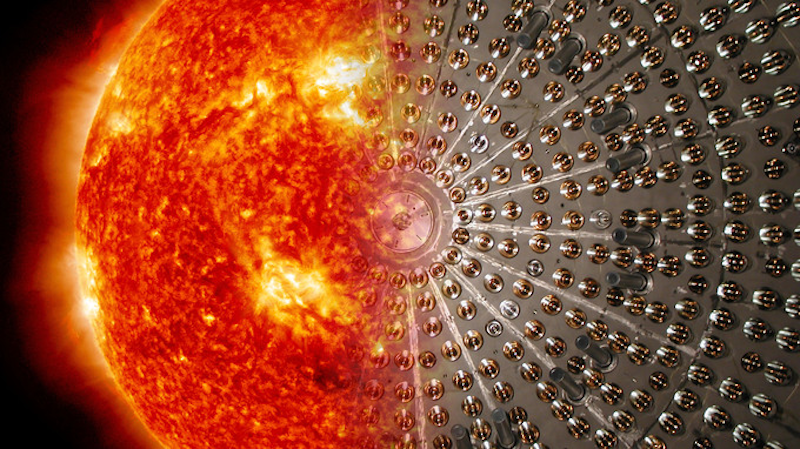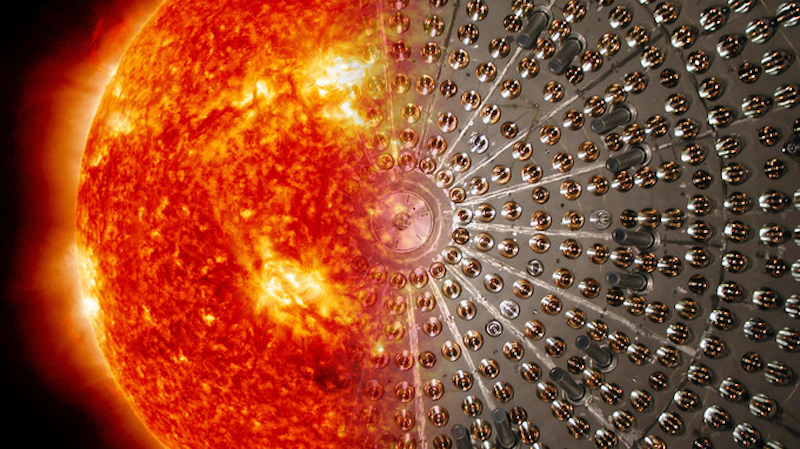A New Day Awaits Solar Neutrinos
Measurements of solar neutrinos proved that our star is powered by nuclear reactions while also bringing to light many other details about the Sun’s inner workings. They also led to the discovery of neutrino oscillations—a phenomenon that is difficult to reconcile with established theories. Current neutrino research mostly relies on neutrinos generated on Earth by reactors and accelerators. But some physicists argue that there is still a lot to be done with neutrinos generated in the Sun. A new generation of solar-neutrino experiments may help in solving outstanding questions about both neutrinos and solar physics, these scientists say.
The study of solar neutrinos began in the late 1960s. Using a detector filled with dry-cleaning fluid and placed in South Dakota’s Homestake gold mine, physicist Raymond Davis and his colleagues observed the first neutrino signal from the Sun. They were surprised, however, to find that the number of neutrinos was one third of what models predicted—a mystery that led to a “neutrino gold rush,” with many new experiments staking claims to different energy and length scales related to the neutrino behavior. Eventually, physicists explained the missing neutrinos as resulting from oscillations between neutrino flavors (see Nobel Focus: Neutrino and X-ray Vision). These oscillations implied that neutrinos have mass, in tension with the standard model of particle physics.
The study of neutrino oscillations continues with efforts to pin down the neutrino masses and mixing parameters that determine the oscillating behavior. The main target, however, is no longer solar neutrinos. “The majority of the community, by a large margin, is focused on accelerator neutrinos,” says Michael Smy from the University of California, Irvine. The reason for this shift, he says, is that an accelerator experiment can explore higher-energy neutrinos and control the source-detector distance over which oscillations may occur. Researchers can also switch the accelerator on and off, which helps remove certain backgrounds.
On the flip side, there are advantages to using solar neutrinos. For one, the interactions between neutrinos and detector materials are generally better understood at the low energies that characterize solar neutrinos, Smy says. Solar neutrinos also come to us for “free,” so the experiments can be less expensive, says Wick Haxton from University of California, Berkeley.
Many experiments have focused on solar neutrinos. The Borexino experiment in Italy, for example, was built with the main purpose of collecting low energy (sub-MeV) neutrinos from the Sun. Since the project’s start in 2007, the team has taken several steps to remove large radioactive backgrounds. “Over the years, they’ve actually mapped the whole spectrum of solar neutrinos,” Haxton says. “They were unique in that regard.” This week, the Borexino Collaboration reported observations of the neutrinos from the carbon-nitrogen-oxygen (CNO) cycle (see Viewpoint: Elemental Accounting of the Solar Interior).
Borexino shut down in October 2021, leaving a gap in the detection capability of solar-neutrino studies. “We do not have more data to be analyzed, and therefore the CNO result is the last major output from our experiment,” says Borexino spokesperson Gioacchino Ranucci. The observations of the solar-neutrino spectrum have agreed well with solar-model predictions, and the data have placed important constraints on oscillation parameters. “But there are still questions to be solved” regarding both the Sun’s chemical makeup and “tensions” in the neutrino oscillation picture, says Ranucci.
Haxton sees a missed opportunity in the closing of Borexino without a clear replacement. “There’s some fascinating questions about the Sun that we haven’t answered very well,” he says. Borexino demonstrated, for example, that solar-neutrino observations could help resolve uncertainties about the elemental abundances in the interior of the Sun. But more precise measurements will be needed to determine the initial ingredients out of which the Sun formed, Haxton says. He also would like to see a better accounting of the total energy in solar neutrinos, which might reveal exotic physics going on inside the Sun. Current neutrino detectors cannot provide these measurements, as they are only sensitive to the high-energy end of the solar-neutrino spectrum.
Still, there are several solar-neutrino problems that current and planned detectors can tackle. Smy works on Japan’s Super-Kamiokande (Super-K) experiment, which has been instrumental in understanding neutrinos since it began taking data in 1996. It continues to be a workhorse in neutrino physics, observing neutrinos from the Sun and other sources. Smy says that Super-K’s current solar-neutrino research focuses on the matter effect—a neutrino flavor conversion that occurs in highly dense regions, such as the interior of the Sun and of Earth. The matter effect has already been observed, but Smy and his colleagues continue to analyze Super-K data in the energy region where the matter effect turns on, as this transition may contain signs of nonstandard interactions between neutrinos and other particles.
Another focus of ongoing solar-neutrino research is pinpointing the values for the neutrino oscillation parameters. “There are interesting discrepancies in the data that we very much want to resolve,” says Shirley Li from Fermi National Accelerator Laboratory (Fermilab) in Illinois. She is especially interested in an apparent disagreement between solar-neutrino observations and reactor-neutrino observations. She has looked at whether this problem could be resolved by the Deep Underground Neutrino Experiment (DUNE)—a planned neutrino detector in the Sanford Underground Research Facility (located in the former Homestake Mine where Davis performed his neutrino experiment). DUNE’s main goal is to observe high-energy neutrinos coming from the Fermilab accelerator. But the detector should also be able to detect solar neutrinos at the high-energy end of the solar spectrum, according to an analysis by Li and her colleagues.
In addition to DUNE, other planned neutrino projects could provide new solar-neutrino results. Smy mentions Jiangmen Underground Neutrino Observatory (JUNO), a large neutrino detector in China that is expected to start taking data next year. JUNO has the capability to detect both neutrinos from the Sun and antineutrinos from nuclear reactors. As such, it could test so-called CPT symmetry that assumes a mirror-like relation between matter and antimatter. Further down the road, researchers are proposing to install a neutrino experiment in the China Jinping Underground Laboratory, the deepest scientific facility in the world. “They have the capability of building a Borexino-like detector that’s an order of magnitude larger,” Haxton says. He thinks such an experiment could potentially fill in some of the missing pieces to our understanding of the Sun.
The current lull in solar-neutrino physics may be a product of the earlier excitement surrounding the missing neutrino problem. “Folks were so anxious to solve the general problem that—once it was solved—they moved on to something else,” Haxton says. But he is optimistic that solar-neutrino physics will have its day again. “Physics goes in cycles.”
–Michael Schirber
Michael Schirber is a Corresponding Editor for Physics Magazine based in Lyon, France.





